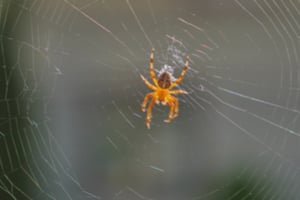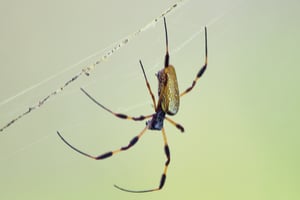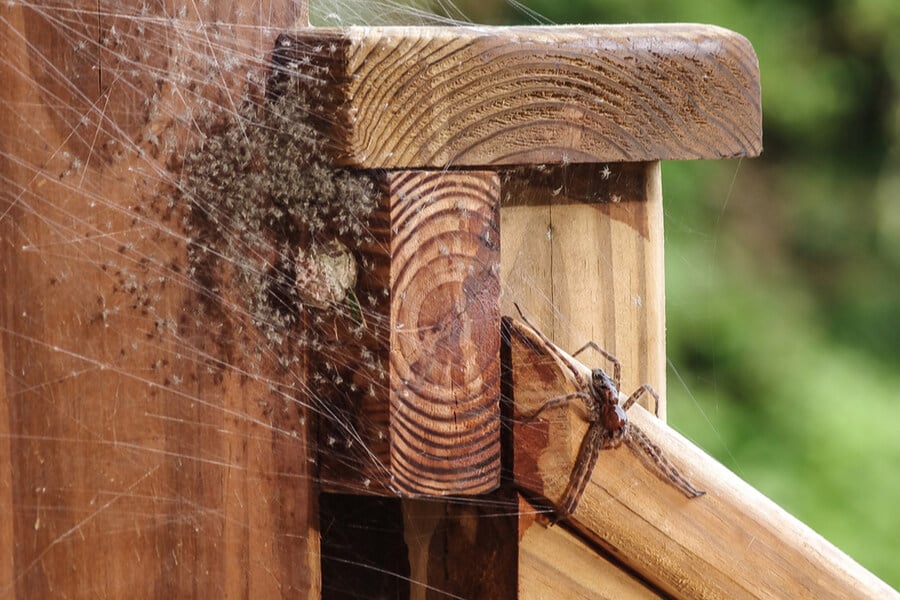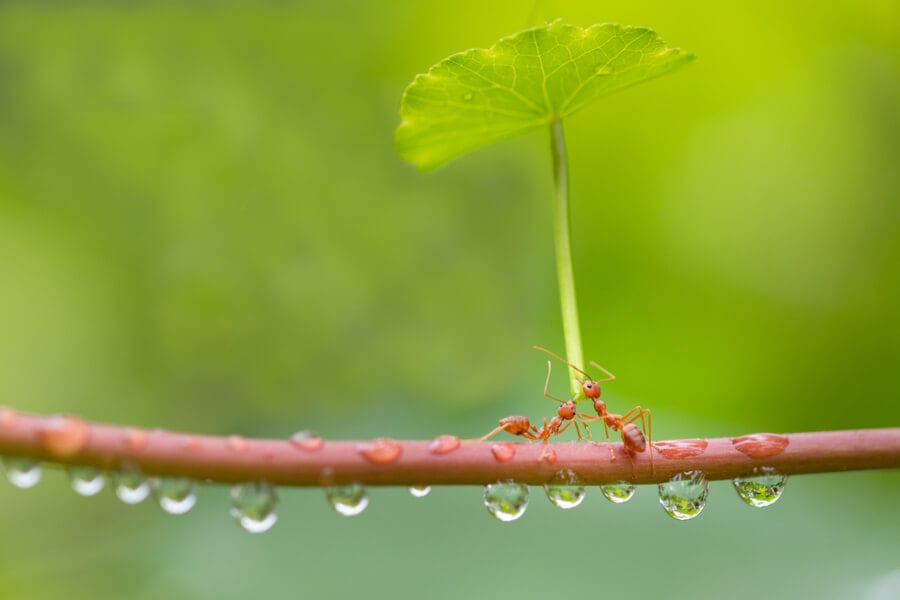Why spider webs are amazing
 Spider silk isn’t just super strong, or super elastic, or super resilient. It’s all of these things at once. First of all: a given weight of spider silk is five times stronger than the same weight of steel. Despite this incredible tensile strength, spider silk is also almost as elastic as rubber on a weight-to-weight basis. Some spider silk can stretch up to four times its original length without breaking or losing its strength.
These two qualities result in a material that’s two to three times tougher than synthetic fibers like Kevlar. You know, the stuff they make bulletproof vests out of. All that, and spider silk is natural, biodegradable, and even antimicrobial. Humans have been fascinated by spider silk for thousands of years, and that fascination continues to this day. If scientists could develop a means of artificially synthesizing spider silk, it would have countless revolutionary applications.
Spider silk isn’t just super strong, or super elastic, or super resilient. It’s all of these things at once. First of all: a given weight of spider silk is five times stronger than the same weight of steel. Despite this incredible tensile strength, spider silk is also almost as elastic as rubber on a weight-to-weight basis. Some spider silk can stretch up to four times its original length without breaking or losing its strength.
These two qualities result in a material that’s two to three times tougher than synthetic fibers like Kevlar. You know, the stuff they make bulletproof vests out of. All that, and spider silk is natural, biodegradable, and even antimicrobial. Humans have been fascinated by spider silk for thousands of years, and that fascination continues to this day. If scientists could develop a means of artificially synthesizing spider silk, it would have countless revolutionary applications.
What spider webs are
 The secret to how spider silk can be so strong and so elastic at the same time has to do with its unique chemical makeup. On a molecular level, spider silk is made up of several amino acid proteins arranged in a chain. The two primary amino acids that make up this chain are glycine and alanine. In spider silk, glycine and alanine chain together in “blocks” repetitively. Each of these proteins contain three distinct “regions” that have their own distinct properties.
The region that makes up most of the “body” of both proteins consists of an amorphous, stretchy matrix. This flexible material absorbs kinetic energy and also gives spider silk its elasticity. The other two regions of the protein are embedded within the amorphous region. These regions are both crystalline, meaning they’re very tough and they resist stretching. One of the two regions is also rigid. The less rigid crystalline region of the proteins moves along with the amorphous portion. Meanwhile, the crystals in the rigid region lock together with the crystals in the non-rigid region. This relationship allows the rigid crystalline region to move with the amorphous regions without stretching or breaking. The result is spider silk that is strong, tough, and elastic all at once.
The secret to how spider silk can be so strong and so elastic at the same time has to do with its unique chemical makeup. On a molecular level, spider silk is made up of several amino acid proteins arranged in a chain. The two primary amino acids that make up this chain are glycine and alanine. In spider silk, glycine and alanine chain together in “blocks” repetitively. Each of these proteins contain three distinct “regions” that have their own distinct properties.
The region that makes up most of the “body” of both proteins consists of an amorphous, stretchy matrix. This flexible material absorbs kinetic energy and also gives spider silk its elasticity. The other two regions of the protein are embedded within the amorphous region. These regions are both crystalline, meaning they’re very tough and they resist stretching. One of the two regions is also rigid. The less rigid crystalline region of the proteins moves along with the amorphous portion. Meanwhile, the crystals in the rigid region lock together with the crystals in the non-rigid region. This relationship allows the rigid crystalline region to move with the amorphous regions without stretching or breaking. The result is spider silk that is strong, tough, and elastic all at once.
How spider webs are made
 All spider species extrude silk from specialized “spinnerets” located on their abdomens. A spinneret is the external part of a spider’s silk gland. Silk glands organically produce and store the “precursor” state of spider silk. When spiders consume protein, a portion is broken down and rebuilt into the precursor components of spider silk. In its precursor state, spider silk is a kind of crystalline liquid gel.
To transform precursor liquid into its silk state, it must pass through a series of ducts. These ducts connect the spinneret to the silk gland. When liquid silk passes through these ducts, cells in the ducts draw water out from it. When the dehydrated liquid silk reaches the spinneret gland, a second duct introduces hydrogen into it. This combination creates an acid bath within the gland. The acid bath transforms the liquid protein into a gel. The spider then pulls this gel through a tiny opening in the spinneret, forcing it into its extremely slender form. Spider silk gel congeals into a solid form immediately upon contacting air.
All spider species extrude silk from specialized “spinnerets” located on their abdomens. A spinneret is the external part of a spider’s silk gland. Silk glands organically produce and store the “precursor” state of spider silk. When spiders consume protein, a portion is broken down and rebuilt into the precursor components of spider silk. In its precursor state, spider silk is a kind of crystalline liquid gel.
To transform precursor liquid into its silk state, it must pass through a series of ducts. These ducts connect the spinneret to the silk gland. When liquid silk passes through these ducts, cells in the ducts draw water out from it. When the dehydrated liquid silk reaches the spinneret gland, a second duct introduces hydrogen into it. This combination creates an acid bath within the gland. The acid bath transforms the liquid protein into a gel. The spider then pulls this gel through a tiny opening in the spinneret, forcing it into its extremely slender form. Spider silk gel congeals into a solid form immediately upon contacting air.
What spider webs are for
 Webs aren’t the only thing spiders use their silk for. There are actually a wide variety of different kinds of spider silk. Each variety has different a relative strength, elasticity, toughness, and consistency. Most spiders can actually produce multiple varieties of silk by themselves, using multiple different spinnerets. A single spider can make as many as seven different types of silk! All cobwebs are actually made up of multiple forms of silk, each of which has its own structural purpose.
There are seven types of spinneret gland and therefore seven types of silk. They are:
Webs aren’t the only thing spiders use their silk for. There are actually a wide variety of different kinds of spider silk. Each variety has different a relative strength, elasticity, toughness, and consistency. Most spiders can actually produce multiple varieties of silk by themselves, using multiple different spinnerets. A single spider can make as many as seven different types of silk! All cobwebs are actually made up of multiple forms of silk, each of which has its own structural purpose.
There are seven types of spinneret gland and therefore seven types of silk. They are:
- The Major Ampullate gland Spinneret: Anterior. Silk: This gland produces “dragline” silk, which forms the outer rim and spokes of webs.
- The Flagelliform gland Spinneret: Posterior. Silk: “Viscid” or “flagelliform” silk, which spiders use to create the sticky spiral rows of their webs.
- The Aggregate gland Spinneret: Posterior. Silk: A “glue-like” silk used to aid in capturing prey alive. This gland is unusual because it produces glue-like droplets along with its silk.
- The Minor Ampullate gland Spinneret: median anterior. Silk: A basic silk that’s used as temporary scaffolding during web construction.
- The Cylindrical gland Spinneret: median posterior. Silk: “Tubiliform” silk, which the spider uses to create protective eggsacs.
- The Aciniform gland Spinneret: median posterior. Silk: “Aciniform” silk, used to wrap up and secure freshly capture prey.
- The Piriform gland Spinneret: anterior. Silk: used to connect other types of silk together, to create a stable web.









